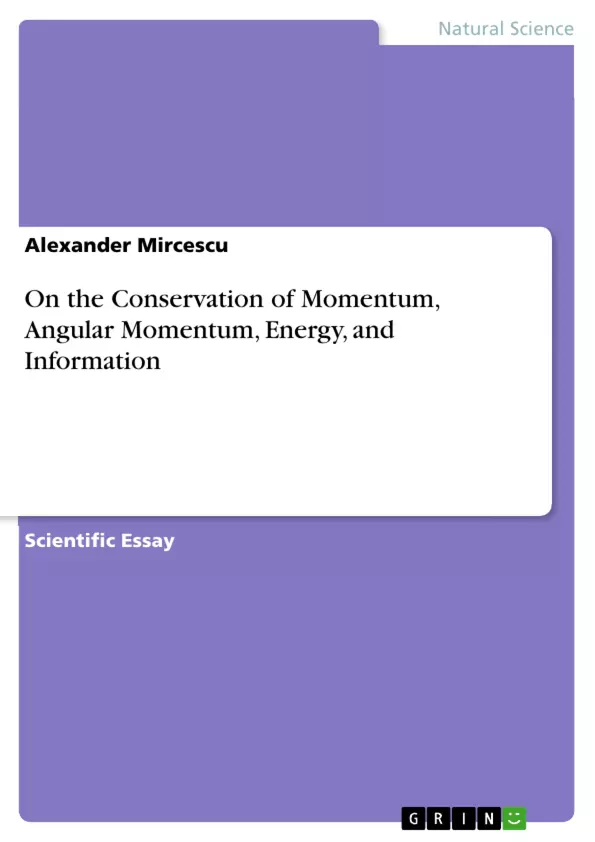This paper shows that the conservation of momentum, angular momentum, and energy leads to a conservation of information in physics. Information and causality lead to an uncertainty principle in physics.
Frequently asked questions
What is Torque (T) and how is it defined?
Torque, denoted as T, is a vector function of angle (θ) and time (t). It is defined by the units N⋅m and can be applied in a jump manner to a particle or body. The torque function does not allow a conservation law.
How is Momentum (p) related to force and time?
Momentum (p) is obtained by integrating the force (F) over time (t) and is dependent on space but no longer on time. Unlike force, momentum allows a conservation law in a closed system.
What is the principle of conservation of momentum in a closed system?
In a closed system, the total momentum before an interaction is equal to the total momentum after the interaction, meaning momentum is conserved.
How are translational and rotational units mapped in physics?
Translational and rotational movements require a mapping of units. For example, force corresponds to torque, mass corresponds to moment of inertia, momentum corresponds to angular momentum, etc.
How is Angular Momentum (L) related to torque and time?
Angular momentum (L) is obtained by integrating the torque over time and is a vector function dependent on the angle but no longer on time. Like momentum, angular momentum allows a conservation law.
What is Overall Momentum?
Overall momentum is the superposition of translational momentum (p) and rotational momentum (L).
How is Energy (E) obtained and what are its dependencies?
Energy (E) is obtained by integrating the force in space and the torque in the angle. It's a scalar function dependent on time but not longer on space or the angle because those dependencies disappear during the integration.
What is Information (I) and how is it defined in the context of physics?
Information (I) is obtained by integrating the force in space and time, and the torque in the angle and in time, or by integrating momentum in space and angular momentum in the angle, or by integrating energy in time. It is a scalar that is independent of space and time. It can be derived from force and is tied to units used in information technology.
What are the units used to define Information (I)?
Information (I) is defined by the units N⋅m⋅s⋅m or kg⋅m2⋅s.
What are Planck units and why are they important?
Planck units use universal constants (gravitational constant G, speed of light c, Planck constant h) to define units of measurement, particularly for force, torque, momentum, angular momentum, energy, and information.
What is the significance of the gravitational constant (G) in defining force?
The gravitational constant (G) is crucial in defining the force between two particles/bodies, described as F=G*m1*m2/r2, and known as the 'matter equation'.
What is the significance of the Speed of Light (c) in defining energy?
The Speed of Light (c) is crucial in defining the relationship between matter and energy, expressed by the equation E=mc2, and known as the 'energy equation'.
What is the significance of the Planck Constant (h) in defining information?
The Planck constant (h) is important when defining the relationship between energy and frequency/time, expressed as E=hv, and known as the 'information equation'. Heisenberg's uncertainty principle states that is the smallest possible information.
What are Petri nets and how do they represent information?
Petri nets are defined in [3]. Petri nets represent the causal relationship of information pieces. Circles are called places and represent the state of a system. We can identify the places with information as described above. The rectangle is called transition and represents, together with the arrows, the causal relationship between the Information pieces.
How does physical measurement disturb a system, according to quantum theory?
Physical measurements, such as using a photon to measure an electron, inherently disturb the system being measured due to the interaction guided by laws like conservation of energy, momentum, and angular momentum.
What is Corollary 5?
Corollary 5: The validity of the laws for conservation of energy, momentum, and angular momentum leads to the law of conservation of information. No information gets lost during a measurement.
What is Corollary 9?
Corollary 9: Since momentum and angular momentum are quantities describing the features of particles, momentum and angular momentum can be viewed as features of matter. Therefore, we have conservation laws describing how matter, energy, and information are conserved.
What is Corollary 10?
Corollary 10: The substances matter (as defined by its momentum and angular momentum), energy, and information lead to an uncertainty relation in their existence forms, space, time, and causality.
How is information viewed differently in physics versus information technology?
In physics, information is conserved; however, information technology rates information based on usability, potentially leading to perceived 'information loss' when undesired information exists. This rating does not, however, contradict the physical conservation laws for momentum, angular momentum, energy, and information.
- Citation du texte
- Alexander Mircescu (Auteur), 2016, On the Conservation of Momentum, Angular Momentum, Energy, and Information, Munich, GRIN Verlag, https://www.grin.com/document/343915



